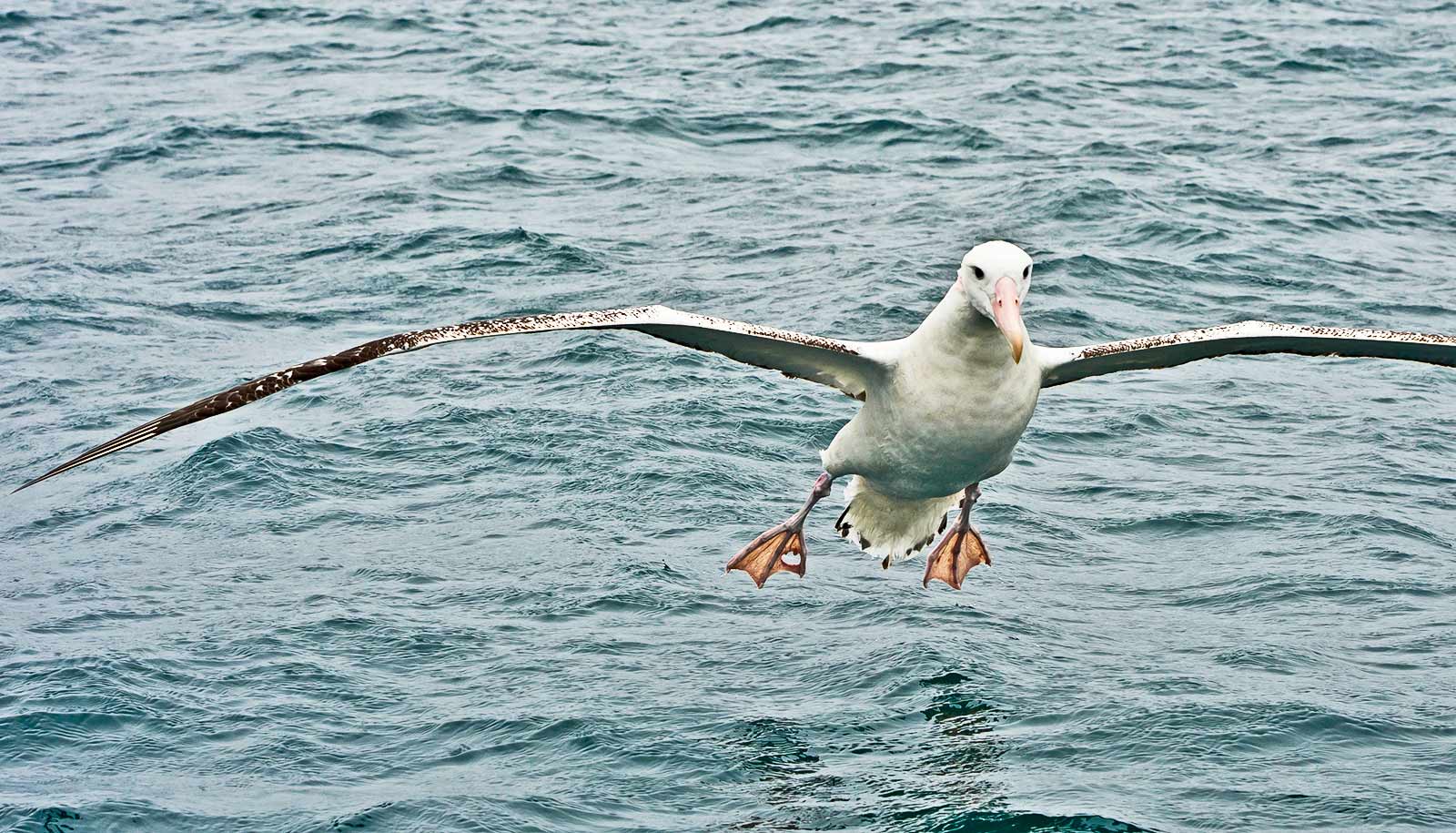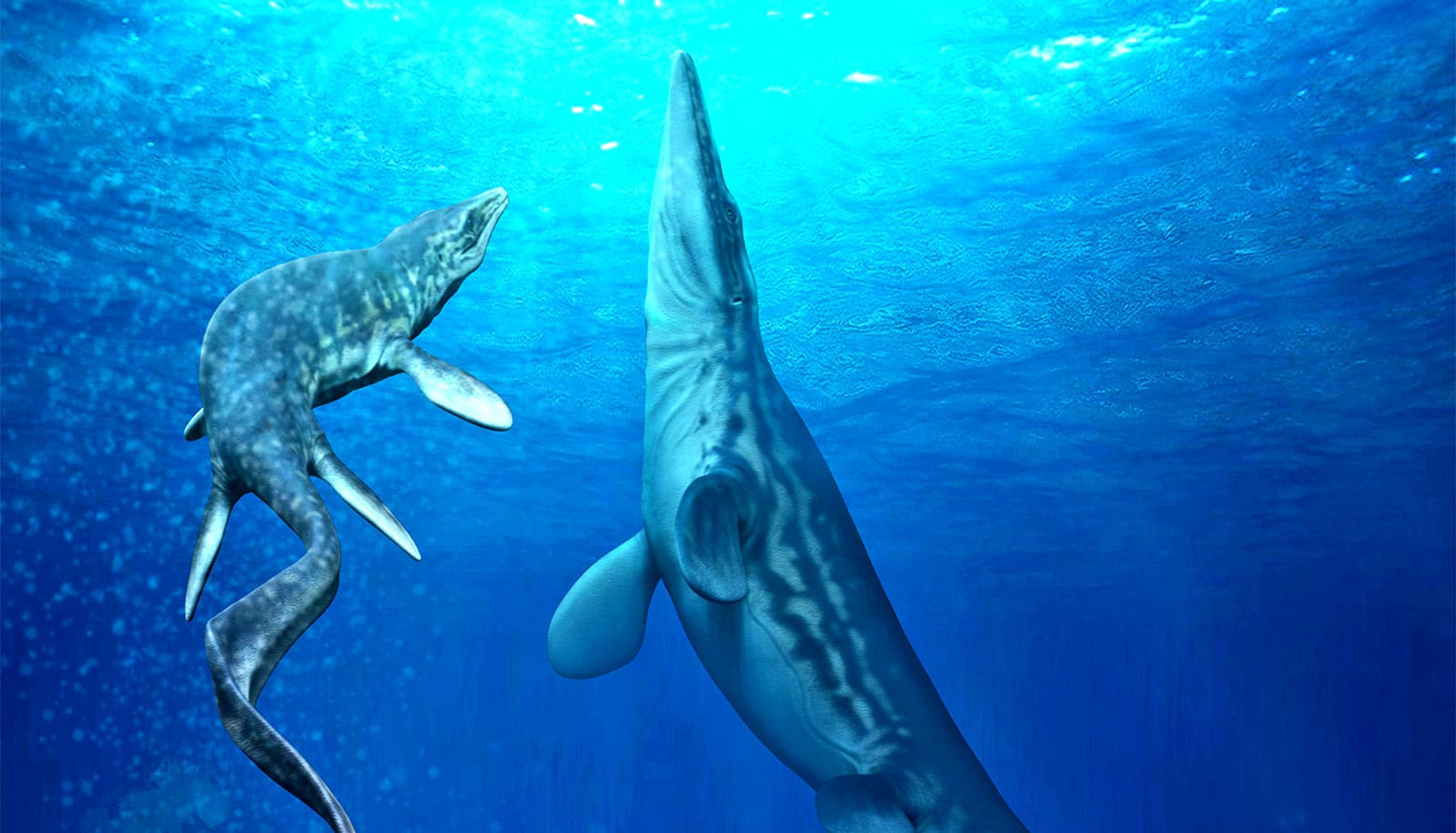Ancient birds with wingspans up to 21 feet once patrolled the southern oceans, according to fossils recovered from Antarctica in the 1980s.
The birds represent the oldest giant members of an extinct group of birds that would dwarf the 11.5-foot wingspan of today’s largest bird, the wandering albatross.
“The big ones are nearly twice the size of albatrosses, and these bony-toothed birds would have been formidable predators…”
Called pelagornithids, the birds filled a niche much like that of today’s albatrosses and traveled widely over Earth’s oceans for at least 60 million years. Though a much smaller pelagornithid fossil dates from 62 million years ago, one of the newly described fossils—a 50 million-year-old portion of a bird’s foot—shows that the larger pelagornithids arose just after life rebounded from the mass extinction 65 million years ago, when birds’ relatives, the dinosaurs, went extinct. A second pelagornithid fossil, part of a jaw bone, dates from about 40 million years ago.
“Our fossil discovery, with its estimate of a 5-to-6-meter wingspan—nearly 20 feet—shows that birds evolved to a truly gigantic size relatively quickly after the extinction of the dinosaurs and ruled over the oceans for millions of years,” says Peter Kloess, a graduate student at the University of California, Berkeley and lead author of a paper describing the fossil in Scientific Reports.
The last known pelagornithid is from 2.5 million years ago, a time of changing climate as Earth cooled, and the ice ages began.

The pseudoteeth of pelagornithids
Pelagornithids are known as “bony-toothed” birds because of the bony projections, or struts, on their jaws that resemble sharp-pointed teeth, though they are not true teeth, like those of humans and other mammals. The bony protrusions were covered by a horn-like material, keratin, which is like our fingernails. Called pseudoteeth, the struts helped the birds snag squid and fish from the sea as they soared for perhaps weeks at a time over much of Earth’s oceans.
Large flying animals have periodically appeared on Earth, starting with the pterosaurs that flapped their leathery wings during the dinosaur era and reached wingspans of 33 feet. The pelagornithids came along to claim the wingspan record in the Cenozoic, after the mass extinction, and lived until about 2.5 million years ago. Around that same time, teratorns, now extinct, ruled the skies.
The birds, related to vultures, “evolved wingspans close to what we see in these bony-toothed birds (pelagornithids),” says coauthor Ashley Poust of the San Diego Natural History Museum. “However, in terms of time, teratorns come in second place with their giant size, having evolved 40 million years after these pelagornithids lived. The extreme, giant size of these extinct birds is unsurpassed in ocean habitats.”
The fossils that the paleontologists describe are among many collected in the mid-1980s from Seymour Island, off the northernmost tip of the Antarctic Peninsula, by teams led by UC Riverside paleontologists. These finds subsequently moved to the UC Museum of Paleontology at UC Berkeley.
Kloess stumbled across the specimens while poking around the collections as a newly arrived graduate student in 2015.
Reviewing the original notes by former UC Riverside student Judd Case, now a professor at Eastern Washington University, Kloess realized that the fossil foot bone—a so-called tarsometatarsus—came from an older geological formation than originally thought. That meant that the fossil was about 50 million years old instead of 40 million years old. It is the largest specimen known for the entire extinct group of pelagornithids.
The other rediscovered fossil, the middle portion of the lower jaw, has parts of its pseudoteeth preserved; they would have been up to 3 cm (1 inch) tall when the bird was alive. The approximately 12-cm-long ((5 inches) preserved section of jaw came from a very large skull that would have been up to 60 cm (2 feet) long.
Using measurements of the size and spacing of those teeth and analytical comparisons to other fossils of pelagornithids, the authors are able to show that this fragment came from an individual bird as big, if not bigger, than the largest known skeletons of the bony-toothed bird group.
At the ‘bird playground’
Fifty million years ago, Antarctica had a much warmer climate during the time known as the Eocene and was not the forbidding, icy continent we know today, notes coauthor Thomas Stidham of the Institute of Vertebrate Paleontology and Paleoanthropology at the Chinese Academy of Sciences in Beijing.
Alongside extinct land mammals, like marsupials and distant relatives of sloths and anteaters, a diversity of Antarctic birds occupied the land, sea, and air.
The southern oceans were a playground for early penguin species, as well as extinct relatives of living ducks, ostriches, petrels, and other bird groups, many of which lived on the islands of the Antarctic Peninsula. The new research documents that these extinct, predatory, large- and giant-sized bony-toothed birds were part of the Antarctic ecosystem for over 10 million years, flying side-by-side over the heads of swimming penguins.
“In a lifestyle likely similar to living albatrosses, the giant extinct pelagornithids, with their very long-pointed wings, would have flown widely over the ancient open seas, which had yet to be dominated by whales and seals, in search of squid, fish, and other seafood to catch with their beaks lined with sharp pseudoteeth,” says Stidham.
“The big ones are nearly twice the size of albatrosses, and these bony-toothed birds would have been formidable predators that evolved to be at the top of their ecosystem.”
“[Museum] collections are vastly important, so making discoveries like this pelagornithid wouldn’t have happened if we didn’t have these specimens in the public trust, whether at UC Riverside or now at Berkeley,” Kloess says. “The fact that they exist for researchers to look at and study has incredible value.”
Source: UC Berkeley

